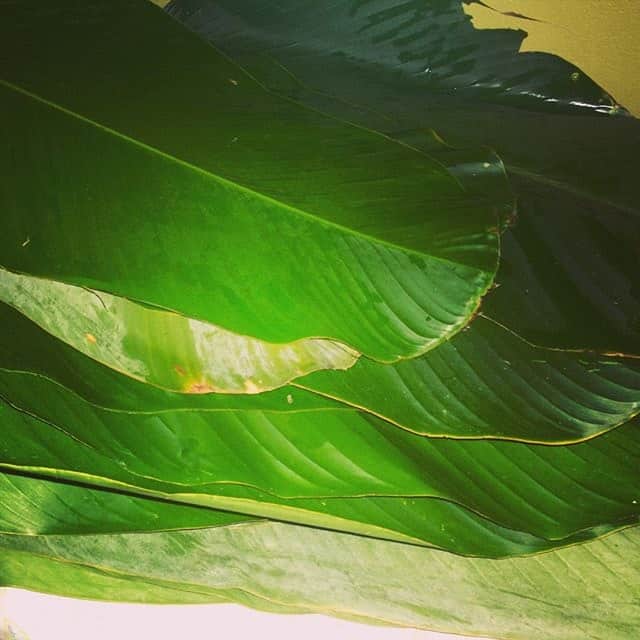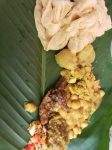The versatile sohari leaf or Indian Wedding Leaf:
THE FESTIVAL of Divali is characterised by several activities of religious significance – special prayers, fasting and the lighting of deyas to name a few.The festival is also characterised by the delicious feast enjoyed with friends and family, traditionally served on a large leaf. So have you ever thought about your “roti leaf ”? What exactly is this thing you are about to eat off of? It is the leaf of the sohari (Calathea lutea).
This relative of the ginger is widespread in areas that are well-watered – often along the banks of streams or abandoned agricultural plots and estates. Indeed, because of its usefulness, it is not uncommon for people to keep a clump handy in their backyards.
Sohari is a native species, found through much of South America.It is a vigorous plant and can easily spread to new areas by seed – characteristics which make it an invasive species in other countries where it is not naturally occurring (St Lucia for example).
Of course, while it is referred to as sohari in Trinidad, it carries a range of different names in other parts of its range including cachibou, pampano, prayer plant and Cuban/ Havana cigar.
Additionally, some local writers use the alternative spelling of “soharee”.
The leaves of the sohari are long and wide, typically measuring about 1.5ft wide and 3 ft in length. It is their size – along with their abundance, low cost, ease of harvesting, relative cleanliness and disposability– that makes the sohari a popular feeding surface at Divali celebrations, Hindu weddings and other occasions.
The flowers are relatively inconspicuous, being small and yellow and borne on brown flower bracts (which themselves might be mistaken for flowers).
As for the origin of the practice, a likely explanation is given in the following excerpt from www.trinigourmet.
com: “Soharee is a bhojpuri word that means ‘food for the gods’.Originally the word soharee was associated with a special kind of roti served to Brahmins at religious functions. The small rotis were basted in ghee and served on the large leaves found in Trinidad. Soon the leaves adopted the name of the rotis themselves. These days, the word soharee is most commonly associated with the large leaves used as plates at religious functions. Indian food needs space because of the variety of dishes served. This is why a large leaf such as the soharee is preferred to accommodate rice, kharee, curry mango, pumpkin, potato, channa, bhajee and salad.” Of course, newcomers to the practice of eating on a sohari leaf should be cautioned.
There is a classic Trinidadian joke about an Englishman who attended a traditional East Indian wedding.
When asked how he enjoyed the meal, he said that the curry was delicious but that the lettuce was rather hard.
But sohari is more than just a “roti leaf ” and its usefulness in food preparation and presentation is well known throughout the neotropics.
The underside of a sohari leaf is covered by a thin waxy layer. This provides a degree of waterproofing which makes the leaves useful in the preparation of tamales in parts of South America. This tradition lives on in Trinidad to an extent, as sohari leaves are sometimes used in pastille production (although banana leaves are evidently preferred).The leaves are also used to wrap a traditional Colombian guava jam called bocadillo de guayaba.
The wax on the leaf ’s surface has not gone unnoticed by industry, and there has been some research into the harvesting and procession of this resource for modern applications (including dentistry). Even without removing it from the plant, the waxy sohari leaves can be used in lining baskets and boxes. Furthermore, fibres stripped from the stems of sohari are dried and used in basket weaving and handicraft.
The plants themselves are considered ornamental thanks to their beautiful leaves and curious flower bracts and so find their way into the gardens of some international plant collectors.
At the time of writing, sohari plants were being offered for sale on the Internet at surprising prices – a package of 50 seeds or a single plant root (a rhizome) would set you back as much as TT $65 (in the equivalent currency).
For the student of natural history, sohari has another interesting feature. If you have a clump of sohari nearby, go take a look at it now. Later this evening, take a look at it again. If you do, you may realise that the leaves have moved! The plant actually responds to changes in light levels; the leaves tend to point upwards and fold at midday, ostensibly to reduce excessive direct exposure to the sun.
So whether you sit down to eat on one later today or happen to pass one growing in the wilds, hopefully you will now know a little bit more about this fascinating plant.Hopefully, it will remain a part of our cultural and natural heritage for a long time to come.
For more info on our natural environment, contact the Trinidad and Tobago Field Naturalists’ Club at admin@ttfnc.org or visit www.ttfnc.org and our Facebook or YouTube pages. The club’s next monthly meeting will be held on November 12, at St Mary’s College, Port-of-Spain. Lecture: “The business of butterflies” by Imran
Thursday 5 November 2015 Kris Sookdeo https://archives.newsday.co.tt/2015/11/05/the-versatile-sohari-leaf/
बहुमुखी सोहारी पत्ती या भारतीय शादी का पत्ता:
दिवली का त्योहार धार्मिक महत्व की कई गतिविधियों की विशेषता है – विशेष प्रार्थना, उपवास और कुछ नाम रखने के लिए दीए की रोशनी।
त्योहार भी स्वादिष्ट दावत की विशेषता है जो दोस्तों और परिवार के साथ आनंद लेते हैं, पारंपरिक रूप से एक बड़े पत्ते पर परोसा जाता है। तो क्या आपने कभी अपने “रोटी पत्ती” के बारे में सोचा है? वास्तव में यह क्या है जो आप खाने के बारे में हैं? यह सोहारी (कैलाथे लुटिया) का पत्ता है।
अदरक का यह रिश्तेदार उन क्षेत्रों में व्यापक है जो अच्छी तरह से पानी वाले हैं – अक्सर धाराओं या परित्यक्त कृषि भूखंडों और सम्पदा के किनारे। दरअसल, इसकी उपयोगिता के कारण, लोगों के लिए अपने पिछवाड़े में एक मोटा काम करना असामान्य नहीं है।
सोहारी एक देशी प्रजाति है, जो दक्षिण अमेरिका के अधिकांश हिस्सों में पाई जाती है।
यह एक जोरदार पौधा है और बीज द्वारा आसानी से नए क्षेत्रों में फैल सकता है – विशेषताओं जो इसे अन्य देशों में एक आक्रामक प्रजाति बनाती हैं जहां यह स्वाभाविक रूप से नहीं होता है (उदाहरण के लिए सेंट लूसिया)।
बेशक, जबकि इसे त्रिनिदाद में सोहारी के रूप में संदर्भित किया जाता है, यह अपनी श्रेणी के अन्य हिस्सों में अलग-अलग नामों की एक श्रृंखला रखता है जिसमें कैचीबो, पैम्पानो, प्रार्थना संयंत्र और क्यूबा / हवाना सिगार शामिल हैं।
इसके अतिरिक्त, कुछ स्थानीय लेखक “सोहरी” की वैकल्पिक वर्तनी का उपयोग करते हैं।
सोहरी की पत्तियाँ लंबी और चौड़ी होती हैं, जो आमतौर पर लगभग 1.5 फीट चौड़ी और 3 फीट की होती हैं। यह उनके आकार के साथ-साथ उनकी बहुतायत, कम लागत, कटाई में आसानी, सापेक्षिक स्वच्छता और डिस्पोज़ेबिलिटी है – जो कि दहारी उत्सवों, हिंदू शादियों और अन्य अवसरों पर सोहारी को एक लोकप्रिय खिला सतह बनाती है।
फूल अपेक्षाकृत अगोचर होते हैं, छोटे और पीले होते हैं और भूरे रंग के फूलों की छाल पर पैदा होते हैं (जो खुद फूलों के साथ गलत हो सकते हैं)।
अभ्यास की उत्पत्ति के लिए, www.trinigourmet के निम्नलिखित अंश में एक संभावित व्याख्या दी गई है।
com: “सोहारी एक भोजपुरी शब्द है जिसका अर्थ है ‘देवताओं के लिए भोजन’।
मूल रूप से सोहेरी शब्द एक विशेष प्रकार की रोटी से जुड़ा था जो धार्मिक कार्यों में ब्राह्मणों को दी जाती थी। छोटी रोटियों को घी में पकाया जाता था और त्रिनिदाद में पाए जाने वाले बड़े पत्तों पर परोसा जाता था। जल्द ही पत्तियों ने खुद रोटियों के नाम को अपनाया। इन दिनों, धार्मिक कार्यों में प्लेटों के रूप में उपयोग किए जाने वाले बड़े पत्तों के साथ सोहेरी शब्द सबसे अधिक जुड़ा हुआ है। विभिन्न प्रकार के व्यंजन परोसे जाने के कारण भारतीय भोजन को स्थान की आवश्यकता है। यही कारण है कि चावल, खैरी, कढ़ी आम, कद्दू, आलू, चना, भाजी और सलाद को समायोजित करने के लिए सोहेरी जैसे बड़े पत्ते को पसंद किया जाता है। ” बेशक, एक सोहरी पत्ती पर खाने के अभ्यास के लिए नए लोगों को सावधानी बरतनी चाहिए।
एक अंग्रेज के बारे में एक क्लासिक त्रिनिदाद मजाक है जो एक पारंपरिक पूर्व भारतीय शादी में शामिल हुआ था।
यह पूछे जाने पर कि उन्होंने भोजन का आनंद कैसे लिया, उन्होंने कहा कि करी स्वादिष्ट थी लेकिन लेट्यूस कठिन था।
लेकिन सोहरी सिर्फ एक “रोटी का पत्ता” से अधिक है और भोजन तैयार करने और प्रस्तुति में इसकी उपयोगिता पूरे नियोट्रॉपिक्स में अच्छी तरह से जानी जाती है।
एक सोहारी पत्ती के नीचे एक पतली मोमी परत द्वारा कवर किया गया है। यह वॉटरप्रूफिंग की एक डिग्री प्रदान करता है जो पत्तियों को दक्षिण अमेरिका के कुछ हिस्सों में तमले तैयार करने में उपयोगी बनाता है। यह परंपरा एक हद तक त्रिनिदाद में रहती है, क्योंकि कभी-कभी पत्ती का उपयोग पास्टील उत्पादन में किया जाता है (हालांकि केले के पत्तों को मुख्य रूप से पसंद किया जाता है)।
पत्तियों का उपयोग एक पारंपरिक कोलंबियाई अमरूद जैम को बोकाडिलो डी गुआयाबा को लपेटने के लिए भी किया जाता है।
पत्ती की सतह पर मोम उद्योग द्वारा किसी का ध्यान नहीं गया है, और आधुनिक अनुप्रयोगों (दंत चिकित्सा सहित) के लिए इस संसाधन की कटाई और जुलूस में कुछ शोध हुए हैं। यहां तक कि पौधे से इसे हटाने के बिना, मोमी सोहारी के पत्तों का उपयोग अस्तर की टोकरी और बक्से में किया जा सकता है। इसके अलावा, सोहर के तने से छीनने वाले तंतुओं को सुखाकर टोकरी की बुनाई और हस्तकला में उपयोग किया जाता है।
पौधों को खुद को उनकी खूबसूरत पत्तियों और जिज्ञासु फूलों की छाल के लिए सजावटी माना जाता है और इसलिए वे कुछ अंतरराष्ट्रीय संयंत्र संग्राहकों के बगीचों में अपना रास्ता ढूंढते हैं।
लेखन के समय, सोहारी पौधों को आश्चर्यजनक कीमतों पर इंटरनेट पर बिक्री के लिए पेश किया जा रहा था – 50 बीज या एक पौधे की जड़ (एक प्रकंद) का पैकेज आपको टीटी $ 65 (समकक्ष मुद्रा में) के रूप में वापस सेट करेगा।
प्राकृतिक इतिहास के छात्र के लिए, सोहारी की एक और दिलचस्प विशेषता है। यदि आपके पास आस-पास सोहरियों का झुरमुट है, तो अब इसे देख लें। इस शाम के बाद, फिर से इस पर एक नज़र डालें। यदि आप करते हैं, तो आप महसूस कर सकते हैं कि पत्ते चले गए हैं! पौधे वास्तव में प्रकाश के स्तर में परिवर्तन का जवाब देता है; पत्तियां ऊपर की ओर इंगित करती हैं और दोपहर के समय मोड़ती हैं, सूर्य के अत्यधिक प्रत्यक्ष जोखिम को कम करने के लिए, संभवतः।
तो क्या आप आज एक के बाद एक खाने के लिए बैठते हैं या विल्ड्स में से एक को पार करने के लिए होता है, उम्मीद है कि अब आप इस आकर्षक पौधे के बारे में थोड़ा और जान पाएंगे।
उम्मीद है, यह आने वाले लंबे समय तक हमारी सांस्कृतिक और प्राकृतिक विरासत का हिस्सा बना रहेगा।
हमारे प्राकृतिक पर्यावरण के बारे में अधिक जानकारी के लिए त्रिनिदाद और टोबैगो फील्ड नेचुर से संपर्क करें






Leave a Reply
You must be logged in to post a comment.